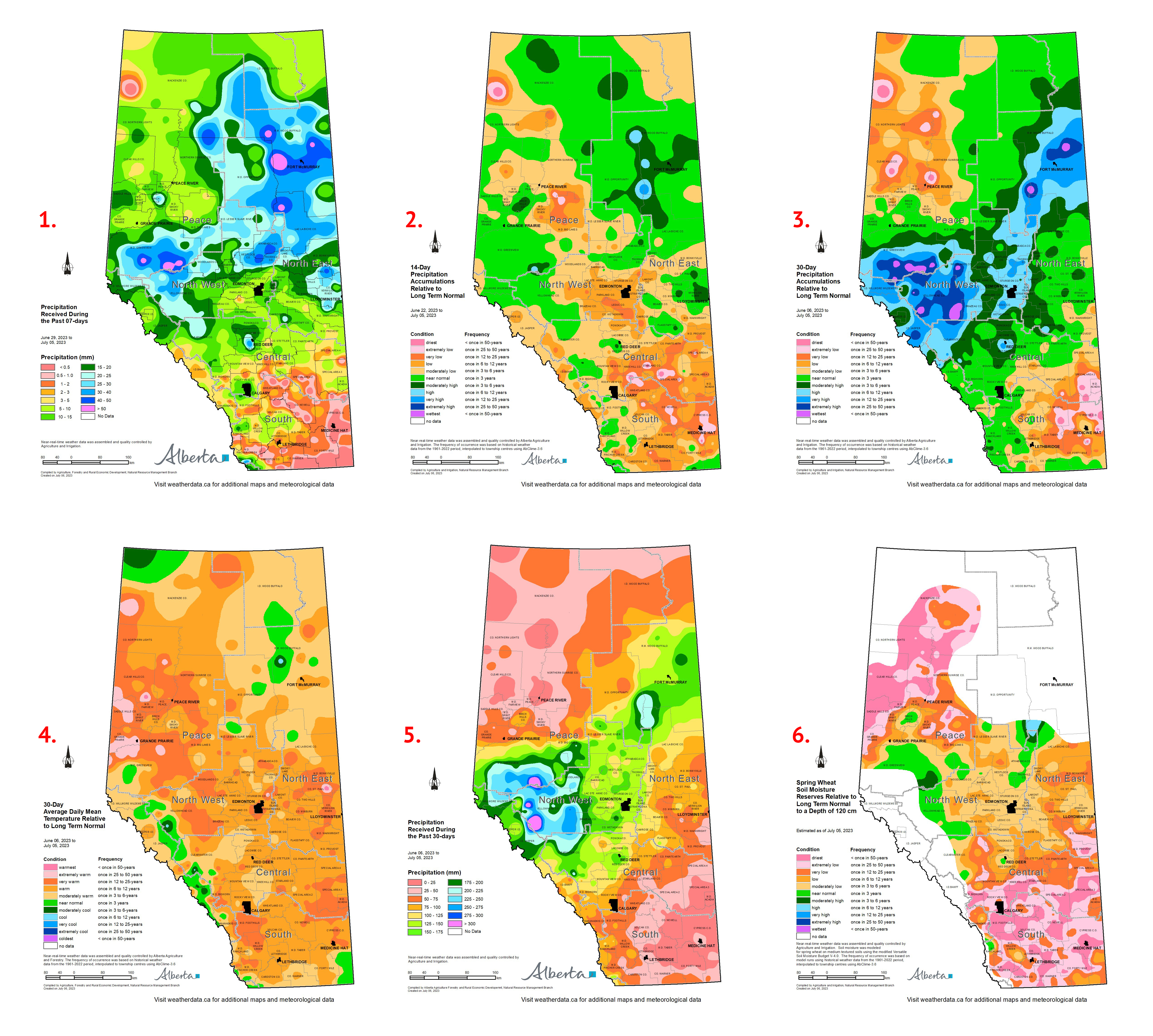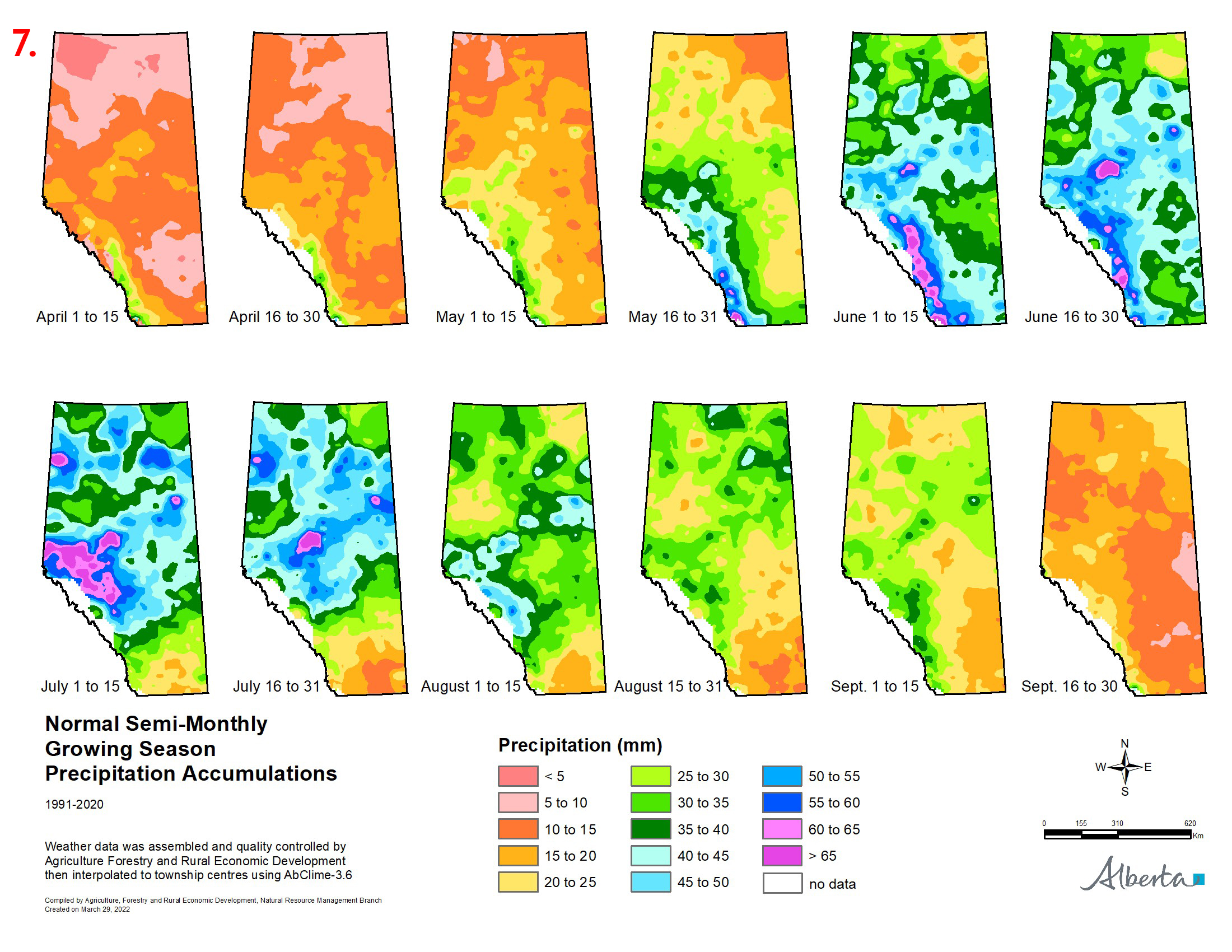Moisture Updates - July 5, 2023
Synopsis
Map 1: Since the last report (June 28, 2023), wide spread rain fell across most of the province from about Red Deer to almost as far North as Grande Prairie (Map 1). Most lands within this large area received at least 10 mm of rain with upwards of 20 mm falling across the extreme Southern Peace Region, and through significant parts of the Northwest and Northeast regions. Generally North of Grand Prairie and through other parts of the Northeast, Northwest and Central Regions, many lands only received modest amounts of rain (5 to 10 mm). This was probably just enough to sustain current yield potentials, but more rain will be needed soon in these areas. In contrast, across the Southern and Central Regions, rainfall was highly variable but many areas remained dry with large areas receiving well below 5 mm and many others, receiving virtually none.
Recent Precipitation Patterns over the Past 30 Days
Maps 2, 3, 4 & 5: The last two weeks of June and first two weeks of July are historically the wettest four week period in the year for those lands in the province, lying roughly North of Calgary. In general, most areas have received below normal rainfall over the past two weeks (Map 2) with only a few widely scattered areas receiving at least near normal moisture during this critical time. Much of the Southern and Central Region have remained dry, and typically the beginning of July marks the start of the dry season in this part of Alberta. Thus looking forward these areas will need above average moisture to maintain current growth.
Over the past 30-days, most of the Northwest has received above average rainfall (Map 3), thanks to a large wide spread event that struck during the third week in June. Elsewhere, most of the Northeast, the Southern Peace Region and smaller parts of the Central and Southern Regions have had near normal moisture for this time frame. In sharp contrast, most of the Northern half of the Peace Region, and about 15% of the Central Region and 40% of the Southern Region, have been experiencing at least once in six year lows for rainfall, with some areas trending to well below once in 25 year lows. This has been accompanied by above average temperatures (Map 4) and moisture stress is impacting yield potential.
Map 5 shows the total precipitation accumulations over the last 30-days and is a relatively a good description of current crop moisture stress. Areas with more than 75 mm should be doing relatively well. Lands in the 50 to 75 mm range are likely doing ok, but more moisture would have been very beneficial. Areas in pink (50-25 mm) dark pink (< 25 mm) are experiencing a chronic a lack of moisture that is acutely evident in many crops. Rain is needed here now as soil moisture reserves are depleted. In contrast, across the Northwest, some lands have received well over 175 mm and may currently be too wet to support optimum growing conditions. A warm dry spell here would help to dry out excessive moisture and allow access to land for field operations.
Soil Moisture Reserves Relative to Normal, as of June 28, 2023
Map 6: Historically soil moisture reserves at this time of year have past their peak levels and are on the decline as long warm days and vigorous plant growth out rainfall accumulations. As such, soil moisture becomes an important secondary source of water to get plants through the long hot days of summer, in the absence of timely rains. Currently, soil moisture reserves are critically low throughout much of the Southern Region, parts of the Central Region and across most of the North half and Western extremes of the Peace Region, approaching one in 50-year lows in many areas (Map 6). These lands need moisture now and in the weeks ahead, to sustain struggling crops as the weather turns warmer and, for the South, typically much drier.
Perspective
Map 7: Long term seasonal precipitation patterns indicate that July tends to mark a dramatic shift from the wet season to the dry season for those lands lying roughly South of the TransCanada Highway (Map 7). As a result, irrigation is necessary here to ensure reasonable year to year crop yields. For lands North of about Olds and extending throughout most of the Northwest and Northeast Regions, the wet season extends throughout the month of July and the onset of the dry season typically holds off till about mid-August, thus most years crops do reasonably well. Finally, across the Peace Region, the beginning of August marks the start of the dry season limiting cropping success in some years. Notably, the dry areas of the Northern Peace region are entering their wettest four week period of the year (July). However, close examination of the maps shows that the June to July period are typically a bit drier across parts of the Central-West Peace Region, making this a challenging area to grow consistent crops year to year, particularly relative to many other areas of the province, with the exception of the South. With ample water supplies this area would benefit from irrigation infrastructure.
Currently, the Northern Peace Region and much of the Southern Region need rain now and will need ongoing, regular rains to help get crops through to harvest. At this point in time, it’s difficult to predict what Mother Nature has in store for these dry areas. The meteorological record is replete with many examples of abrupt shifts from dry to wet and wet to dry. For these areas, it’s likely that yield potential has been set under a moisture stressed regime, but further moisture will be needed to sustain that yield potential.
In order to recover depleted soil moisture reserves for next year’s cropping cycle wetter weather will be need this fall, winter and early spring. Failing this, the 2024 crops will be very reliant on late May, June, and July moisture.
Contact Us
Saddle Hills
Junction of Hwy 49 & Secondary Hwy 725
RR1, Spirit River AB
T0H 3G0
T. 780-864-3760
Fax 780-864-3904
Toll-free 1-888-864-3760
frontdesk@saddlehills.ab.ca
Sign up to our Newsletter
Stay up to date on the Saddle Hills activities, events, programs and operations by subscribing to our eNewsletters.


